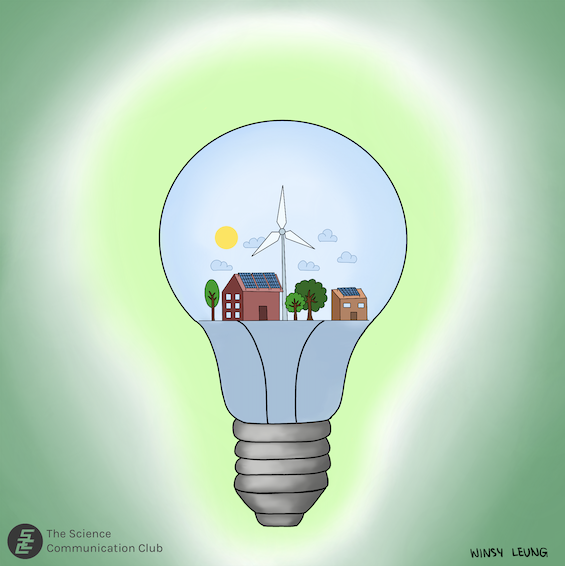
Written by Quinn Lui
Illustrated by Winsy Leung
Plenty of heat comes from inside a house: people and pets generate body heat, and appliances like the oven can warm a whole room! However, every building loses heat through its surfaces and openings. In colder regions, keeping a house warm during the winter can be incredibly expensive—on more than just the financial front. Concerns about the environmental costs of private residences have led to the increasing popularity of net-zero energy homes, which are designed to only use as much energy as they can sustainably produce on their own. To do this, they have to minimize energy loss and maximize the amount of renewable energy coming in.
As a result, the net-zero building’s success has to start from the outside, with doors and windows which are as airtight as possible. This prevents heat from leaking out, and cold air from entering. Some houses even include insulation inside their window frames. In general, improving a building’s insulation quality decreases its total energy consumption, because it can retain more internally produced heat.
Speaking of insulation, the materials used—and how they’re made—are crucial aspects of designing a net-zero home, too. For example, foam is a common insulation choice for the average house, but it’s frequently made of non-renewable materials. The process of manufacturing foam also requires a lot of energy, and usually generates a lot of greenhouse gas emissions. It would be hard for a non-zero house to use only as much energy as it could produce on-site, if it had to pay off high energy costs of all its building materials first! The ZeroHouse, an energy-efficient home designed in Toronto, opts for the renewable insulation choices of straw bales and cellulose. Cellulose insulation is often made of paper products that would otherwise be thrown out after being used, like cardboard packaging.
Another way that net-zero houses can be designed to reuse “waste” products is by including heat exchangers. When you take a bath or shower, or run a dishwasher, a plumbing system with a heat exchanger can recover the warmth from the just-used water and use it to heat new water, rather than letting that energy literally go down the drain. Similarly, heat exchangers can use the heat from air circulating out of a house to warm up colder air coming in.
The building’s electricity use matters too. For instance, LED lights consume less energy than standard bulbs. They also last longer before needing to be replaced, making them a more environmentally friendly choice. Of course, if a building isn’t producing its own energy in addition to reducing its consumption, it won’t qualify as truly carbon-neutral—which is why many net-zero buildings have solar panels set on their rooftops. However, they aren’t a practical choice for every location, due to limited roof space in urban areas or a lack of strong sunlight year-round.
One possible alternative to solar energy, at least when it comes to heating and cooling net-zero buildings, is geoexchange technology. When it’s cold, geoexchange systems pump heat from underground and relay it to surrounding buildings in the form of heated water. During warmer months, the process reverses: heat is pumped from the buildings back into the below-ground pipes, allowing the buildings to cool off while the energy is saved for the next winter.
Part of U of T’s current sustainability plan includes incorporating geoexchange technology onto its campuses, starting by drilling pipes underneath King’s College Circle downtown. Meanwhile, at UTSC, a new energy-efficient residence is in the process of being built based on net-zero energy principles.
Sources:
- https://canada.constructconnect.com/dcn/news/projects/2020/11/u-of-t-urban-geoexchange-project-will-be-largest-in-canada
- https://magazine.utoronto.ca/campus/u-of-ts-path-to-a-low-carbon-future-begins-deep-below-kings-college-circle/
- https://www.renewcanada.net/u-of-t-building-one-of-largest-energy-efficient-residences-in-north-america/
- https://passivehouse-international.org/upload/GRBR_EN_2018_Sammelmappe/GRBR_EN_2018_Sammelmappe.html
- https://taf.ca/zerohouse-made-toronto-net-zero-housing-solution/
- https://www.thechemicalengineer.com/features/the-net-zero-house/
- https://www.thespruce.com/cellulose-insulation-basics-1821904